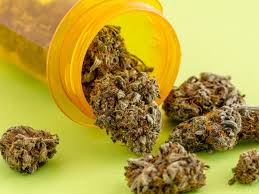Marijuana has been gaining a foothold in the United States. A drug that was once illegal is now legal for recreational use in some states. In 1996, California became the first state to legalize its medical use. Now, in 2018, it is used recreationally in 10 states, and used medically in 23 states. It seems inevitable that this once prohibited plant will be legal in some shape or form in all 50 states within our lifetime. This warrants a closer look into this leafy substance.
The Endogenous Cannabinoid System (ECS) exists within our body. The ECS is made up of G-protein coupled receptors that are activated by cannabinoid-like molecules. Our body has a series of its own cannabinoid molecules called endocannabinoids. There are also exogenous cannabinoids, like marijuana, that can be used to stimulate this system.

Marijuana has numerous effects on the body. Therefore, the drug can be used medically to treat people. According to an article from webmd, doctors may prescribe medical marijuana to treat:
- Alzheimer’s disease

https://www.businessinsider.com/the-biggest-questions-researchers-have-about-marijuana-2017-3 - Appetite loss
- Cancer
- Crohn’s disease
- Eating disorders such as anorexia
- Epilepsy
- Glaucoma
- Mental health conditions like schizophrenia and PTSD
- Multiple sclerosis
- Muscle spasms
- Nausea
- Pain
- Wasting syndrome (cachexia)
As you can see, marijuana can be used in a positive way. However, when it is used recreationally, marijuana could become addictive contrary to popular belief. Marijuana reaches the same pleasure centers in the brain that are targeted by heroin, cocaine and alcohol. While it is widely thought that marijuana is not addictive, about 30 percent users may have some degree of marijuana use disorder, according to NIDA.

Long-term marijuana users who try to quit experience cravings, irritability, sleeplessness, decreased appetite and anxiety — some of the same physical symptoms of those trying to quit other types of drugs or alcohol. A 2016 study found a link between certain genetic markers and symptoms of marijuana addiction, suggesting that some people may have a genetic predisposition to marijuana addiction. According to research from the Potency Monitoring Project, the average THC content of marijuana has soared from less than 1 percent in 1972, to 3 to 4 percent in the 1990s, to nearly 13 percent in 2010. Today, some retail marijuana has 30 percent THC or more. The increased potency makes it difficult to determine the short- and long-term effects of marijuana.
Therefore, I understand the positive impacts of medical marijuana, but marijuana for recreational purposes warrants more research. As this leafy green substance gains popularity in the U.S., more research needs to be published that encompasses the overall picture of the drug. Is it really okay to smoke a little pot? The “blunt” truth is, marijuana may be more harmful than people think if it is used recreationally.
https://www.webmd.com/a-to-z-guides/medical-marijuana-faq#1-3
https://onlinelibrary.wiley.com/doi/full/10.1111/j.1556-4029.2010.01441.x
https://www.drugabuse.gov/publications/research-reports/marijuana/marijuana-addictive
https://www.livescience.com/24558-marijuana-effects.html
